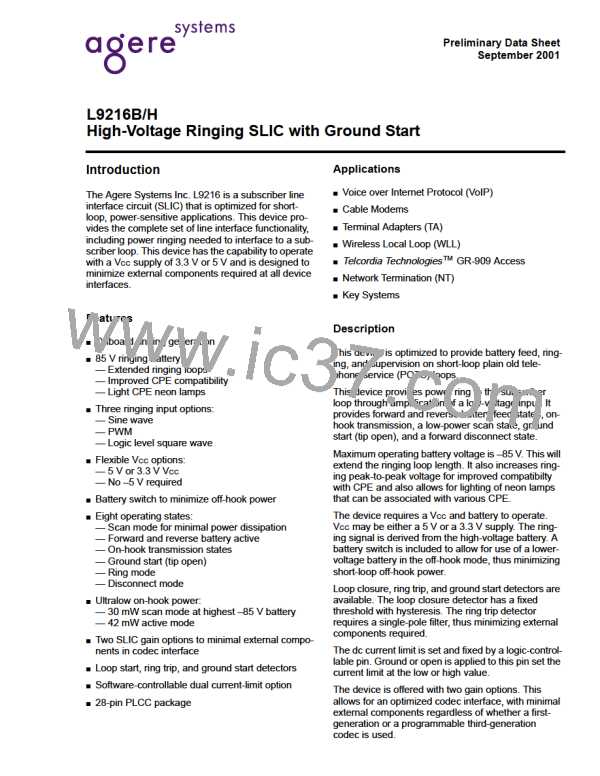L9216B/H
Preliminary Data Sheet
September 2001
High-Voltage Ringing SLIC with Ground Start
Thus, if the total power dissipated in the SLIC is less
than 1.83 W, it will not enter the thermal shutdown
state. Total SLIC power is calculated as:
Applications
Power Control
Total PD = maximum battery • maximum current
Under normal device operating conditions, power dissi-
pation on the device must be controlled to prevent the
device temperature from rising above the thermal shut-
down and causing the device to shut down. Power dis-
sipation is highest with higher battery voltages, higher
current limit, and under shorter dc loop conditions.
Additionally, higher ambient temperature will also
reduce thermal margin.
limit + SLIC quiescent power.
For the L9216, the worst-case SLIC on-hook active
power is 65 mW. Thus,
Total off-hook power = (ILOOP)(Current-Limit
Tolerance)*(VBATAPPLIED) + SLIC on-hook power
Total off-hook power = (0.030 A)(1.08) * (21) +
65 mW
Total off-hook power = 745.4 mW
To support required power ringing voltages, this device
is meant to operate with a high-voltage primary battery
(–65 V to –85 V typically). Thus, power control is nor-
mally achieved by use of the battery switch and an aux-
iliary lower absolute voltage battery. Operating
temperature range, maximum current limit, maximum
battery voltage, minimum dc loop length and protection
resistor values, airflow, and number of PC board layers
will influence the overall thermal performance. The fol-
lowing example illustrates typical thermal design con-
siderations.
The power dissipated in the SLIC is the total power dis-
sipation less the power that is dissipated in the loop.
SLIC PD = Total power – Loop power
Loop off-hook power = (ILOOP * 1.08)2 • (RLOOP(dc)
min + 2RHANDSET)
Loop off-hook power = (0.030 A)(1.08)2 • (20 Ω +
60 Ω + 200 Ω)
Loop off-hook power = 293.9 mW
SLIC off-hook power = Total off-hook power – loop
off-hook power
The thermal resistance of the 28-pin PLCC package is
typically 35.5 °C/W, which is representative of the natu-
ral airflow as seen in a typical switch cabinet with a
multilayer board.
SLIC off-hook power = 745.4 mW – 293.9 mW
SLIC off-hook power = 451.5 mW < 1.83 W
Thus, under the operating conditions of this example,
the thermal design, using the auxiliary, is adequate to
ensure the device is not driven into thermal shutdown
under worst-case operating conditions.
The L9216 will enter thermal shutdown at a tempera-
ture of 150 °C. The thermal design should ensure that
the SLIC does not reach this temperature under normal
operating conditions.
For this example, assume a maximum ambient operat-
ing temperature of 85 °C, a maximum current limit of
30 mA, a maximum battery of –85 V, and an auxiliary
battery of –21 V. Assume a (worst-case) minimum dc
loop of 20 Ω of wire resistance, 30 Ω protection resis-
tors, and 200 Ω for the handset. Additionally, include
the effects of parameter tolerance.
1. TTSD – TAMBIENT(max) = allowed thermal rise.
150 °C – 85 °C = 65 °C
2. Allowed thermal rise = package thermal
impedance • SLIC power dissipation.
65 °C = 35.5 °C/W • SLIC power dissipation
SLIC power dissipation (PD) = 1.83 W
Agere Systems Inc.
21

 ZARLINK [ ZARLINK SEMICONDUCTOR INC ]
ZARLINK [ ZARLINK SEMICONDUCTOR INC ]